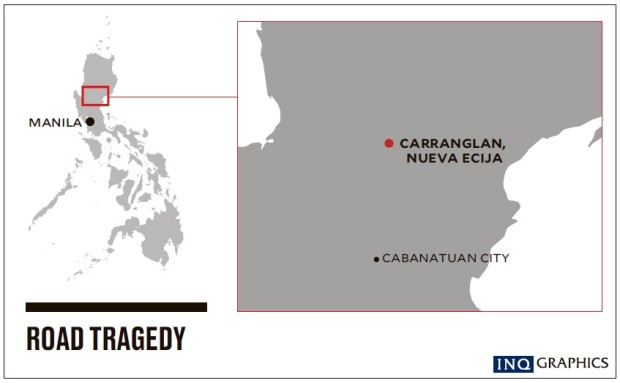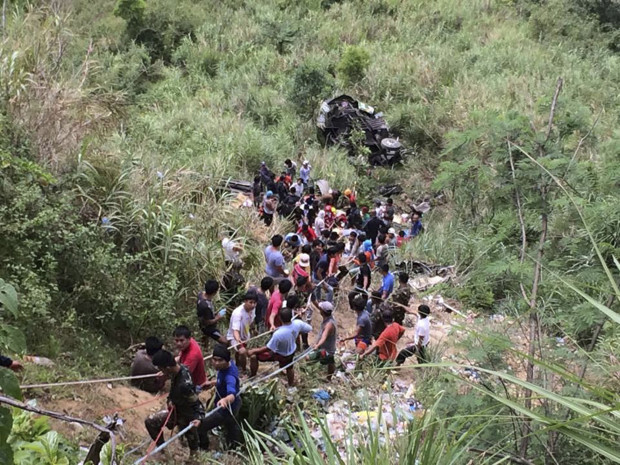Bus crash kills 32 in Nueva Ecija
At least 32 people were killed when their bus plunged into a ravine in Carranglan, Nueva Ecija province, on Tuesday in one of the country’s deadliest road accidents in recent years, police said.
Initial reports said the driver failed to stop the bus because of malfunctioning brakes, but investigators later saw that one of its front tires had burst, which could have caused the vehicle to fall into the 24-meter ravine, according to Senior Insp. Robert de Guzman, Carranglan police chief.
De Guzman said the Leomarick Bus was traveling from Isabela province to Ilocos Sur province when the crash happened around noon.
Ian Fernandez, one of the survivors, said the engine stopped moments after the bus drove down the Cagayan Valley-Nueva Ecija Highway, a few kilometers from Dalton Pass at the boundary of Nueva Ecija and Nueva Vizcaya provinces.
Fernandez, 31, who was traveling with his wife and daughter, said he jumped out of the bus as it fell off the road. His wife and daughter were injured and taken to a hospital in Bayombong, Nueva Vizcaya.
Article continues after this advertisementRed Cross count
Nearly all the dead, including the driver, and injured were taken to health centers and hospitals in Sta. Fe, Aritao, Bambang and Bayombong towns in Nueva Vizcaya.
Article continues after this advertisementThe Red Cross chapter of Nueva Vizcaya listed 29 fatalities but the police had 32.
Senior Insp. Ariel Gabuya of the Sta. Fe police office in Nueva Vizcaya, whose officers were first to arrive at the scene, said 11 died on the spot. He said 14 others died at the Nueva Vizcaya provincial hospital in Bambang, six in a hospital and a health center in Aritao, and one at San Jose City hospital in Nueva Ecija.
Gabuya said at least 38 others were taken to separate hospitals for treatment of various injuries.
A farmer near the bottom of the ravine heard a deafening sound from the highway and people screaming for help as the bus plunged.
“I saw this giant object hurtling down toward me,” said Pancito Agcrio, 59, who was tending a garden about 20 meters from where the bus landed.
“Most of the passengers suffered broken wrists. Some I saw crawling out of the bus. I learned they died later,” he said. “It was heartbreaking. The crash site was littered with dead people. And the people who were alive were crying. They couldn’t walk.”
Wreckage site
Rescuers who descended into the deep ravine struggled with ropes to pluck the passengers from the wreckage, disaster response officer Mark Raymond Cano told The Associated Press.
Many of the survivors who were taken to a hospital had serious injuries, Cano said.

One of them, Ruben Angobung, municipal registrar of Tumauini, Isabela, said he was stunned by the scene and hopped out of his vehicle to help pull the ropes to retrieve the bodies.
The impact of the crash appeared to have ripped the top off the vehicle, De Guzman told the French news agency Agence France-Presse.
“Almost all of the passengers, both dead and injured, were found outside the bus,” he said.
Palace statement
Presidential spokesperson Ernesto Abella expressed Malacañang’s “deep condolences” to the families of the victims.
“We guarantee that the culprits behind the fatal bus mishap will be held accountable,” he added.
Fernandez said the bus, which was designed for 45 people, carried as many as 70 passengers, with some sitting on the laps of their companions.
Poorly maintained passenger buses, inadequate road safety features and weak enforcement of local transport laws have been blamed for many vehicular accidents.
In February, a sightseeing bus carrying college students on a camping trip lost its brakes on a steep downhill road and smashed into a concrete electrical post in Tanay, Rizal province, east of Manila, leaving 15 people dead.
In February 2014, a tour bus rolled off a mountain road into a ravine in Bontoc, Mountain Province, killing 14 passengers, including two foreigners. —WITH REPORTS FROM LEILA B. SALAVERRIA, VILLAMOR VISAYA JR., AP AND AFP
